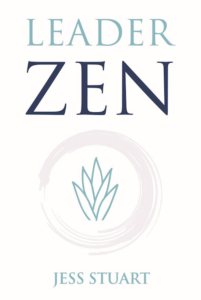 An extract from the book LeaderZEN by Jess Stuart www.jessstuart.co.nz/leaderzen
An extract from the book LeaderZEN by Jess Stuart www.jessstuart.co.nz/leaderzen
“Knowing others is intelligence. Knowing yourself is true wisdom. Mastering others is strength. Mastering yourself is true power.” – Lao Tzu
The secret to achieving your potential is to first know yourself. This means connecting to your values, knowing who you are and what you bring to the table; understanding your strengths and limitations and unpicking some of your limiting beliefs. Once you have the awareness, you must then have the confidence and self-efficacy in who you are and what you stand for. This is standing in your power and leading authentically, which we’ll talk more about.
Once we have mastered self-knowledge, we need the energy to deliver on what we know we’re capable of, and this is the other side of the coin: leading ourselves.
We often think about leadership as something we do to, and for, others, yet it always starts with us. Without this deep understanding of ourselves we cannot be effective leaders or lead with confidence. This plays into our performance, our resilience, and of course, our energy.
That brings me to this concept of self mastery and probably the centre pin of the Zen view. Whether it’s martial arts or meditation, the Zen masters have a deep intimate knowledge of themselves, and the utmost self-control as a result.
When we have mastered ourselves, the rest is easy, but mastering ourselves is one of the hardest things to achieve.
When we have developed self mastery, we move forward consciously and steadily towards our goals. We know our purpose, and we have the self-discipline needed to do things in an intentional, focused way. Self mastery also means mastering our emotions, impulses, and actions, and is vital in terms of leadership brand.
Think about people you know who don’t have any self-mastery. They’re probably impulsive and might let their emotions control them. They’re unpredictable and, as a result, people are less likely to trust them.
The kind of skills we associate with self mastery include much of what we’ll go on to talk about in this book; self-awareness, discipline, emotional intelligence, positive thinking and equanimity are key elements.
A conscious leader is aware not just of themselves, but also of others and their environment. Conscious leaders are awake to opportunities; they can read a room and they often know what’s going on before anyone has spoken a word. This deep awareness gives them an advantage and is achieved through self mastery.
The best ways to build awareness are through reflective practices and gathering feedback. Practising awareness is also a key aspect of mindfulness and presence, which we will cover in later chapters.
What have you done to learn about yourself on your leadership journey so far? Probably a personality test which would have put you in a box based on stereotypical norms. Perhaps a 360-degree appraisal which will have given you an insight into what others think, and can be useful as a starting point. For self mastery we must go beyond the basics though. Let’s get practical and start to learn more about ourselves. We can’t just talk about self mastery without doing the work. Some of you might be further along on this journey, in which case these exercises will be easy. For others, it’ll provide a valuable starting point on this path of self-discovery. We’ll look at our strengths and values as well as internal parts of ourselves, and how all this contributes to make up our leadership brand.
Know your strengths
Gallup surveys have found that if we focus on our strengths, we’ll be six times more likely to be engaged at work, eight per cent more productive, and three times more likely to have an excellent quality of life. It’s no wonder, given their data, they advocate for a strengths based approach to leadership development. Strengths are important, yet we often ignore them in favour of talking about what we need to work on or improve, where our leadership development is concerned. As a nation, we tend to err on the side of modesty. We can find it difficult or embarrassing to accept compliments; we are conditioned to be modest and not to promote our abilities, through fear of being seen as arrogant.
Strengths can also be quite tricky because they feel effortless. If we’re good at something, we tend to find it easy, so we assume it’s nothing special, that everyone must find it this easy. We are predisposed to focus on the things we’re not good at, rather than the things we are. It’s how we’ve evolved and have used to keep us safe. We’re constantly scanning the horizon for the worst that can happen, so we are able to react and prepare for that, which helped us survive back in the days of sabre-tooth tigers. However, in our modern life, this translates to noticing all the things we don’t like about ourselves, the things we’ve not done yet, and where other leaders are performing better.
We’re also very quick to move on to the next thing in our modern world and so don’t spend time reflecting on the positive – what went well, why, and what strengths we used. It’s about rewiring the neural pathways in our brain to see things more evenly. It’s not that life will be any different; we’ll just learn to see more of the positive as well as the negative.
Life has evolved at an amazing pace, and we’ve not caught up. Dr Barbara Fredrickson did some research on ‘positivity ratios’ and found to offset this bias that exists in the brain, we need a ratio of 3:1. That’s three positive thoughts, emotions or experiences to every one negative. There’s a lot of work to be done in this space, as our negativity bias is like a well-worn walking track; we use it often. To even this out, we need to start firing more of the positive neural pathways and breaking down a less-travelled path in the brain. It’s bumpy and overgrown with weeds, and so much more difficult to navigate. It takes time, like training a muscle. We don’t go into the gym and pick up the heaviest weight, and this is similar. It’s not an overnight thing; we start small and build up – it takes practice.
Research has proven that focusing on our strengths makes us more successful, but first, we need to know what they are. Stop for a minute and write down a list of your strengths – all the things you’re good at. What feedback have you received? What did they tell you they’d miss about you when you left your last team?
Values and Brand
Alongside our strengths, our values are an important aspect that determines our brand. When we live by our values, there is a sense of internal rightness and fulfilment. The best way to determine our values is by looking at what we actually do. We also discover our values by exploring what we care deeply about – what makes us tick. It is generally these things that provide the why behind what we do. It’s our essence and who we are at our core, regardless of who is watching.
What are your values? I remember when I was first asked this question. I didn’t even know what values were; I had to Google a list and then start picking out words that resonated. Now I have card decks of values that I use with leaders and teams, to do this similar exercise. It’s a powerful way of becoming more self-aware, but it’s also a powerful way of connecting teams through shared values. Find a list if it helps get you started. Pick ten that apply and then narrow that down to your top five. Our values drive the decisions we make and the way we lead.
Once we know our strengths and our values, we are on the way to articulating our leadership brand. Our brand is what people know us for – our reputation. It’s how we demonstrate our credibility and become known for who we are and what we stand for. It’s something that’s created whether we are intentional about it or not. Based on our actions and behaviour, our brand already exists, and will be known across our teams and colleagues without us intentionally having set out to create it. We are all unique. Part of leveraging our own uniqueness is to understand what we bring to the table, how others perceive us, and what we want to be known for. When building your brand goals, ask yourself the following questions:
• What are my natural strengths?
• What do I do extremely well?
• What do people acknowledge me for?
• How do I add value at work?
Beyond our strengths and values, there’s a third part of this puzzle in understanding who we are, and that’s based on our experience both at work and, most importantly, in life. There will be meaning that we’ve created and lessons that we’ve learned from some of the biggest experiences we’ve had across our lifetime.
Timeline exercise
When I became a thought leader, I invested in my own development at business school, and one of the exercises I found useful was this idea of charting your timeline. This is a way of understanding who you are and how you’ve been shaped. If you were to chart your life on a timeline, what key moments stick out? Life events, relationships, trauma, transformation?
What did they teach you? Start right from your first job as a teenager through to now.
• What big moments happened in your life – what did you learn?
• What are your proudest achievements?
• What are your top successes?









Join the Discussion
Type out your comment here:
You must be logged in to post a comment.